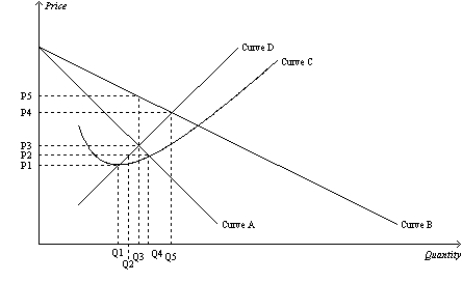A) help to keep prices down.
B) help to prevent a single firm from acquiring ownership of a key resource.
C) encourage creative activity.
D) discourage the production of inefficient products.
F) A) and B)
Correct Answer

verified
Correct Answer
verified
Multiple Choice
Most markets are not monopolies in the real world because
A) firms usually face downward-sloping demand curves.
B) supply curves slope upward.
C) firms usually equate price with marginal cost.
D) there are reasonable substitutes for most goods.
F) C) and D)
Correct Answer

verified
Correct Answer
verified
Multiple Choice
When a single firm can supply a product to an entire market at a lower cost than could two or more firms, the industry is called a
A) resource industry.
B) exclusive industry.
C) government monopoly.
D) natural monopoly.
F) A) and B)
Correct Answer

verified
Correct Answer
verified
Multiple Choice
How does a competitive market compare to a monopoly that engages in perfect price discrimination?
A) In both cases, total social welfare is the same.
B) Total social welfare is higher in the competitive market than with the perfectly price discriminating monopoly.
C) In both cases, some potentially mutually beneficial trades do not occur.
D) Consumer surplus is the same in both cases.
F) A) and B)
Correct Answer

verified
Correct Answer
verified
Multiple Choice
What happens to the price and quantity sold of a drug when its patent runs out? i) The price will fall. Ii) The quantity sold will fall. Iii) The marginal cost of producing the drug will rise.
A) i) only
B) i) and ii) only
C) ii) and iii) only
D) i) , ii) , and iii)
F) B) and C)
Correct Answer

verified
Correct Answer
verified
Multiple Choice
Suppose a monopolist chooses the price and production level that maximizes its profit. From that point, to increase society's economic welfare, output would need to be increased as long as
A) average revenue exceeds marginal cost.
B) average revenue exceeds average total cost.
C) marginal revenue exceeds marginal cost.
D) marginal revenue exceeds average total cost.
F) A) and C)
Correct Answer

verified
Correct Answer
verified
Multiple Choice
Scenario 15-3 A monopoly firm maximizes its profit by producing Q = 500 units of output. At that level of output, its marginal revenue is $30, its average revenue is $60, and its average total cost is $34. -Refer to Scenario 15-3. At Q = 500, the firm's profit is
A) $13,000.
B) $15,000.
C) $17,000.
D) $30,000.
F) B) and D)
Correct Answer

verified
Correct Answer
verified
Multiple Choice
Table 15-18
A monopolist faces the following demand curve:
 Suppose marginal cost is constant at $8 per unit.
-Refer to Table 15-18. When the price effect on revenue is greater than the output effect, marginal revenue is
Suppose marginal cost is constant at $8 per unit.
-Refer to Table 15-18. When the price effect on revenue is greater than the output effect, marginal revenue is
A) positive. This occurs with the 3rd unit of output.
B) positive. This occurs with the 4th unit of output.
C) negative. This occurs with the 5th unit of output.
D) negative. This occurs with the 6th unit of output.
F) None of the above
Correct Answer

verified
Correct Answer
verified
True/False
In a monopoly market, the socially efficient quantity of output is typically higher than the profit-maximizing quantity of output for the monopolist.
B) False
Correct Answer

verified
Correct Answer
verified
Multiple Choice
Figure 15-4  -Refer to Figure 15-4. The average total cost curve for a monopoly firm is depicted by curve
-Refer to Figure 15-4. The average total cost curve for a monopoly firm is depicted by curve
A) A.
B) B.
C) C.
D) D.
F) B) and C)
Correct Answer

verified
Correct Answer
verified
Multiple Choice
A government-created monopoly arises when
A) government spending in a certain industry gives rise to monopoly power.
B) the government exercises its market control by encouraging competition among sellers.
C) the government gives a firm the exclusive right to sell some good or service.
D) Both a and c are correct.
F) A) and B)
Correct Answer

verified
Correct Answer
verified
Multiple Choice
Table 15-6
A monopolist faces the following demand curve:
 -Refer to Table 15-6. What is the marginal revenue from the sale of the 4th unit?
-Refer to Table 15-6. What is the marginal revenue from the sale of the 4th unit?
A) -$3
B) $3
C) $9
D) $24
F) B) and C)
Correct Answer

verified
Correct Answer
verified
Multiple Choice
The first major piece of antitrust legislation was the
A) Clayton Act.
B) Obama Care Act.
C) Sherman Act.
D) Clinton Act.
F) B) and C)
Correct Answer

verified
Correct Answer
verified
Multiple Choice
Table 15-7
Sally owns the only shoe store in town. She has the following cost and revenue information.
 -Refer to Table 15-7. What is the marginal revenue from selling the 8th pair of shoes?
-Refer to Table 15-7. What is the marginal revenue from selling the 8th pair of shoes?
A) $10
B) $20
C) $40
D) $90
F) A) and B)
Correct Answer

verified
Correct Answer
verified
True/False
Suppose a profit-maximizing monopolist faces a constant marginal cost of $10, produces an output level of 100 units, and charges a price of $50. The socially efficient level of output is 200 units. Assume that the demand curve and marginal revenue curve are the typical downward-sloping straight lines. The monopoly deadweight loss equals $4,000.
B) False
Correct Answer

verified
Correct Answer
verified
Multiple Choice
Competitive firms have
A) downward-sloping demand curves, and they can sell as much output as they desire at the market price.
B) downward-sloping demand curves, and they can sell only a limited quantity of output at each price.
C) horizontal demand curves, and they can sell as much output as they desire at the market price.
D) horizontal demand curves, and they can sell only a limited quantity of output at each price.
F) None of the above
Correct Answer

verified
Correct Answer
verified
Multiple Choice
If a monopolist can practice perfect price discrimination, the monopolist will
A) eliminate consumer surplus.
B) eliminate deadweight loss.
C) maximize profits.
D) All of the above are correct.
F) C) and D)
Correct Answer

verified
Correct Answer
verified
Multiple Choice
Suppose a firm has a monopoly on the sale of a computer game and faces a downward-sloping demand curve. When selling the 50th game, the firm will always receive
A) less marginal revenue on the 50th game than it received on the 49th game.
B) more average revenue on the 50th game than it received on the 49th game.
C) more total revenue on the 50 games than it received on the first 49 games.
D) Both b and c are correct.
F) C) and D)
Correct Answer

verified
Correct Answer
verified
Multiple Choice
Which of the following is a characteristic of a natural monopoly?
A) Fixed costs are typically a small portion of total costs.
B) Average total cost declines over large regions of output.
C) The product sold is a natural resource such as diamonds or water.
D) All of the above are correct.
F) A) and B)
Correct Answer

verified
Correct Answer
verified
Multiple Choice
Which of the following statements is not correct?
A) The government may use antitrust laws to break up an existing company to improve competition.
B) The government may break up a natural monopoly to lower the price charged to customers.
C) Private ownership is typically preferred to public ownership.
D) Sometimes the best strategy is for the government to do nothing about monopoly inefficiency because the "fix" may be worse than the problem.
F) A) and B)
Correct Answer

verified
Correct Answer
verified
Showing 581 - 600 of 637
Related Exams